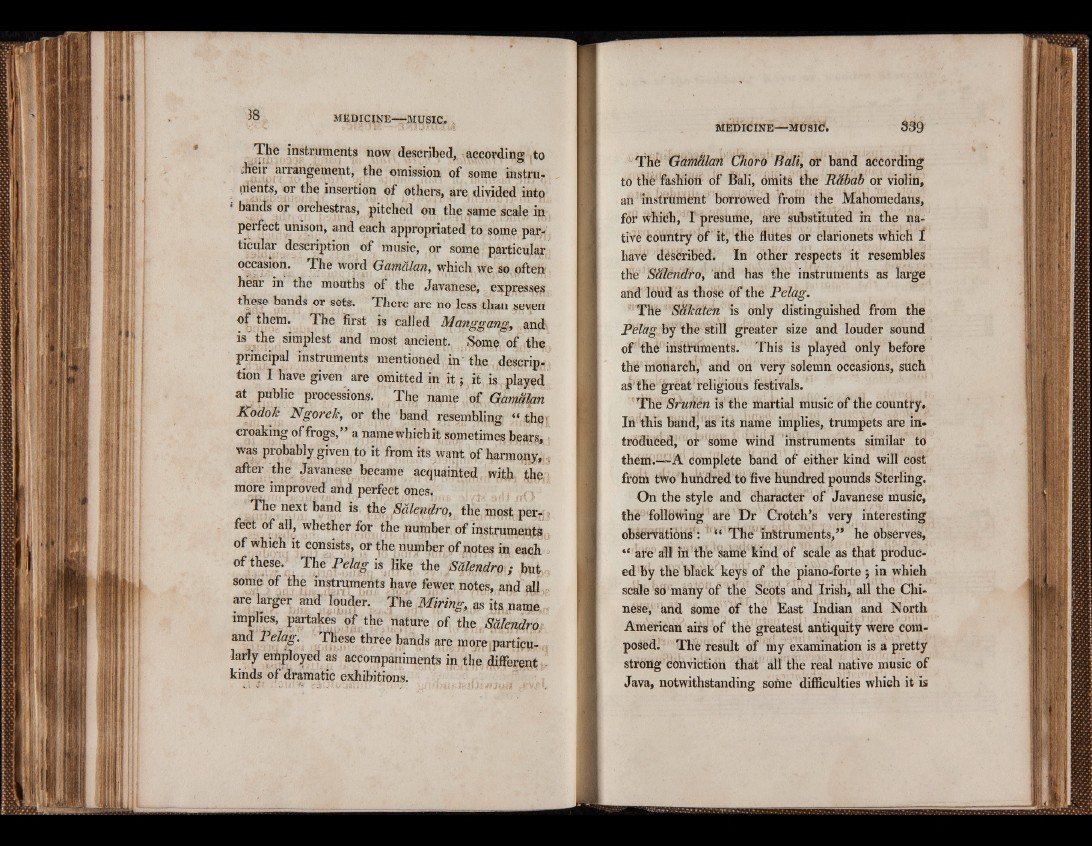
The instruments now described, according to
mit arran»ement> omission of some instruments,
or the insertion of others, are divided into
* bands or orchestras, pitched on the same scale in
perfect unison, and each appropriated to some par-
ticular description of music, or some particular
occasion. The word Gamcdan, which we so often
hear in the mouths of the Javanese, expresses
these bands or sets. There are no less than seven
of them. The first is called Manggang, and
is the simplest and most ancient. Some of the
principal instruments mentioned in the description
I have given are omitted in it j it is played
at public processions. The name of Gamdlan
Kodolc NgoreJc, or the band resembling “ the
croaking of frogs,” a name which it sometimes bears,
was probably given to it from its want of harmony,
after the Javanese became acquainted with the
more improved and perfect ones.
The next band is the Salendro, the most per-
féèt of all, whether for the number of instruments
of which it consists, or the number of notes in each
of tlu;se*' The Pelag is like the Salendro; but
some of the instruments have fewer notes, and all
are larger and louden The Miring, as its name
implies, partakes of the nature of the Salendro
and Pelag. These three bands are moreparticu- q
lafly employed as accompaniments in the different
kinds of dramatic exhibitions.
The Gamdlan Choró Bali, or band according
tò thè fashion of Bali, Omits the Ràbab or violin,
an instrument borrowed from the Mahomedans,
for which, I presume, are substituted in the native
country of it, the flutes or clarionets which 1
have déscribed. In other respects it resembles
the Salendro, and has the instruments as large
and loud as those of the Pelag.
Thè Salcaten is only distinguished from the
Pelag by the still greater size and louder sound
of the instruments. This is played only before
the monarch,' arid on very solemn occasions, such
as the great religious festivals.'
The Srunen is the martial music of the country.
In this band, as its name implies, trumpets are introduced,
or some wind instruments similar to
them.—A complete band of either kind will cost
from two hundred to five hundred pounds Sterling.
On the style and character of Javanese music,
the follhvring are Dr Crotch’s very interesting
observations : ** The instruments,he observes,
“ are all in the samé kind of scale as that produced
by the black keys of the piano-forte \ in whieh
scale so many of the Scots and Irish, all the Chi-
nese, and some of the East Indian and North
American airs of the greatest antiquity were composed.
The result of my examination is a pretty
strong conviction that all the real native music of
Java, notwithstanding some difficulties which it is